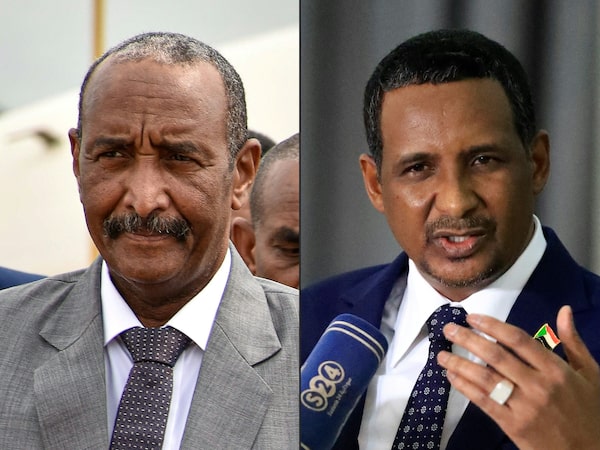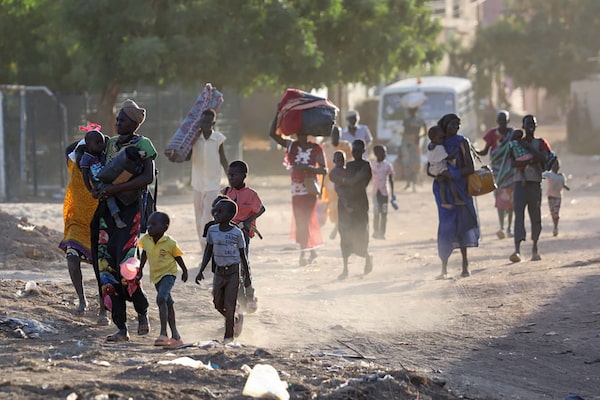
Hundreds of people have been killed since the fighting erupted on April 15 between forces loyal to Sudan's army chief Abdel Fattah al-Burhan and his deputy, Mohamed Hamdan Dagalo, who commands the paramilitary Rapid Support Forces (RSF).-/AFP/Getty Images
Heavy fighting has erupted in Sudan since Saturday, April 15 after weeks of tension between the military and the powerful paramilitary group, Rapid Support Forces (RSF), to gain control of the north-east African country.
The clash has killed hundreds of civilians and spread to more than a dozen towns and cities across Sudan, destroying buildings and leaving hospitals crowded with dead and wounded as artillery and tank fire crashes into densely-populated neighbourhoods.
How did the conflict begin? Who are the central figures involved? What’s at stake? Here’s what to know about the current situation in Sudan.
Why is there conflict in Sudan and what led to the recent violence?

Sudan's army chief, General Abdel Fattah al-Burhan. left, and Gen. Mohamed Hamdan Dagalo, who commands the paramilitary Rapid Support Forces.AKUOT CHOL/AFP/Getty Images
There are two sides in the battles:
- The Sudanese army, led by General Abdel Fattah al-Burhan.
- The Rapid Support Forces militia, led by General Mohamed Hamdan Dagalo.
The Sudanese military and the RSF united to seize power in 2019 by toppling former dictator Omar al-Bashir, and again in 2021 when they launched another coup to block a planned transition to democratic elections.
Since then, the tensions between the two sides have been growing.
Under heavy pressure from the United Nations and Western governments, both Gen. Dagalo and Gen. Burhan signed a preliminary deal in December to hand back power to a civilian-led government this month. During negotiations to reach a final agreement, however, two main disputes emerged: how the RSF would be integrated into the military and who would have ultimate control over fighters and weapons.
On April 15, their feud exploded into violence and the negotiation process has now been further jeopardized by the deadly fighting. On Saturday, the Sudanese military denounced the RSF as “rebels,” while Gen. Dagalo declared that Gen. Burhan would be captured dead or alive.
Both have close links to military forces in other countries in Africa and the Middle East, raising fears of a broader proxy war or regional conflagration.
Sudan is being dragged to the brink of civil war by a power struggle between two men – a career soldier and a former warlord – who rose to power under former autocratic leader Omar al-Bashir.
Reuters
What are the Rapid Support Forces (RSF)?
The RSF was created in 2013, and evolved from its roots in the notorious Janjaweed militia that terrorized Darfur two decades ago. The paramilitary group was widely accused of massacres and other war crimes in Darfur in the early 2000s when former dictator Omar al-Bashir deployed the militia to crush a rebellion in the region.
Gen. Dagalo, known in Sudan by his nickname Hemedti (Little Mohamed), is the commander of the RSF. For years he thrived on alliances with Sudan’s army, ascending to become deputy leader of Sudan’s military regime.
“Bashir created something that neither he nor anyone else in the government, including the regular army, could control,” Nicholas Coghlan, a former Canadian ambassador to Sudan, told The Globe and Mail. “Hemedti grew in influence and power. He acquired gold-mining interests in Darfur, which – as the economy went into free-fall starting four years ago – have given him even more clout.”
The RSF has since expanded its presence across the country and currently has an estimated 100,000 fighters in its ranks, with reported links to Russian military contractors and the armies of several Gulf states.
Where in Sudan is the fighting happening?
Fighting erupted in the centre of Khartoum on Saturday, shutting down its main airport. The clashes have since spread to other areas of the country, including the coastal city of Port Sudan, eastern regions near the borders of Ethiopia and Eritrea, and the war-ravaged Darfur region.
On Thursday, residents reported the heaviest fighting around the main military headquarters in central Khartoum and at the nearby airport. Airstrikes also hit medical facilities in Obeid, the capital of North Kordofan province southwest of Khartoum.
On Friday, gunfire ripped through residential neighbourhoods of Khartoum at the start of the Muslim holiday of Eid al-Fitr. Soldiers and gunmen shot at each other in the north, west and centre of the city, including during the call for special early morning Eid prayers, witnesses said.

LIBYA
Site of clashes between Sudanese
Armed Forces (SAF) and the
Rapid Support Forces (RSF)
(As of April 23)
Detail
SAUDI
ARABIA
SUDAN
ERITREA
CHAD
Khartoum
YEMEN
DJIBOUTI
ETHIOPIA
CENTRAL
SOUTH
SUDAN
AFRICAN
500 km
REPUBLIC
john sopinski/the globe and mail, source: openstreetmap; beam

LIBYA
Site of clashes between Sudanese
Armed Forces (SAF) and the
Rapid Support Forces (RSF)
(As of April 23)
Detail
EGYPT
SAUDI
ARABIA
SUDAN
ERITREA
CHAD
Khartoum
YEMEN
DJIBOUTI
ETHIOPIA
CENTRAL
SOUTH
SUDAN
AFRICAN
500 km
REPUBLIC
john sopinski/the globe and mail, source: openstreetmap; beam

LIBYA
Site of clashes between Sudanese
Armed Forces (SAF) and the
Rapid Support Forces (RSF)
(As of April 23)
EGYPT
Detail
SAUDI
ARABIA
Nile River
Red Sea
SUDAN
ERITREA
Khartoum
CHAD
YEMEN
DJIBOUTI
ETHIOPIA
CENTRAL
AFRICAN
REPUBLIC
SOUTH
SUDAN
500 km
john sopinski/the globe and mail, source: openstreetmap; beam
How many have been killed/injured so far?
More than 500 people, including civilians and combatants, have been killed in Sudan since April 15, with another 4,200 wounded, according to the Sudanese Health Ministry. The Doctors’ Syndicate, which tracks civilian casualties, has recorded at least 295 civilians killed and 1,790 wounded.
Why did the ceasefire(s) fail?

People flee their neighbourhoods amid fighting between the army and paramilitaries in Khartoum on April 19, following the collapse of a 24-hour truce.-/AFP/Getty Images
There have been five ceasefire attempts so far in Sudan. All have been broken. The first was announced by the United Nations for Tuesday. In an all-out push for a ceasefire, UN secretary General Antonio Guterres held a virtual summit with the African Union, Arab League and European Union, among others, a diplomatic source said. The announcement said that the envoys had brokered a brief humanitarian “pause” in the fighting on Sudan.
However, this attempt failed and the violence continued.
Another ceasefire, a 24-hour truce on Wednesday evening, was separately announced by the Sudanese army and its rival RSF. This attempt also only held for a few minutes, and brought only marginal calm to parts of the capital of Khartoum. Many residents took advantage of the ceasefire to flee their homes where they have been trapped for days.
The UN is called for a three-day ceasefire for the Muslim holiday of Eid al-Fitr, which begins on Friday. But there has been little sign of compromise from either side.
On April 27, officials hope to extend an existing three-day ceasefire which brought about a lull in fighting, without completely halting it. It is currently due to expire at midnight.
What is the impact on civilians?
People flee from Khartoum during clashes between the paramilitary Rapid Support Forces and the armyon April 19.EL TAYEB SIDDIG/Reuters
The fighting has been disastrous for a country where the United Nations says around a third of the population — some 16 million people — are already facing hunger and need emergency aid. But the UN and most other relief agencies have largely suspended their programs because of the fierce fighting and the widespread looting of their offices and warehouses.
Khartoum residents have also been desperate for a respite after days of being trapped in their homes, their food and water running out.
Meanwhile, hospitals in Khartoum are running dangerously low on medical supplies, often operating without power and clean water. About 70 per cent of Khartoum’s hospitals have suspended operations because of the heavy fighting. Power outages have also destroyed the cold-chain storage facilities for vaccines, insulin and antibiotics, according to the humanitarian group Save the Children. At least 32 vaccination sites have been affected, and millions of children could soon be at risk of disease, it said.
“My biggest fear is that the health care system collapses, and the consequences will be catastrophic,” said Osama Abubakr Osman, a spokesperson for the Sudanese Red Crescent Society, in a statement on Wednesday. “Health care workers cannot reach hospitals, and hospitals are trying to attend to their patients without electricity and water and running critically short of essential supplies.”
What’s at stake for the region? Is there concern the fighting will spill over Sudan’s borders?
The clashes between Sudan’s regular military and the RSF could drag in neighbouring countries, since each side is backed by a complex web of foreign allies.
The conflict has also raised fears of a spillover from the strategically located nation to its African neighbors. Sudan’s fighting has also caused up to 20,000 Sudanese to seek refuge in eastern Chad, the U.N. said Thursday. At least 320 Sudanese soldiers fled to Chad, where they were disarmed, said Daoud Yaya Brahim, Chad’s defense minister. The troops were apparently fleeing from Darfur, where the RSF is the most powerful armed force.
What is Canada doing? What about other countries?
Hundreds of Canadians are stuck in Sudan with limited resources and while foreign governments are trying to plan evacuations, the main airport in Khartoum is severely damaged from the crossfire.
Defence Minister Anita Anand says the first Canadian evacuation flight from Sudan has taken off and additional evacuations are planned over the next few days. The Canadians left the country on a Hercules search-and-rescue plane and more flights are planned in the coming days using two similar aircrafts in the region. Officials said it is unlikely that Canadian evacuation flights will continue past this week.
The Canadian embassy in Khartoum has also shut down because of the security situation and its staff have taken shelter.
On Tuesday, Prime Minister Justin Trudeau said it’s not easy for Canada to arrange a landing spot in Sudan to evacuate citizens by Canadian military aircraft. So far about 1,800 Canadian citizens in Sudan have registered their presence in the country with Global Affairs. About 700 people have requested assistance, of which more than 500 are Canadian citizens. Others are permanent citizens and the status of some is not known. As of Wednesday, about 180 Canadian citizens had left Sudan on flights operated by allied countries.
In Geneva, the World Health Organization urged the combatants to open a safe corridor for medics and to allow those trapped to flee.
Germany attempted to send three military transport planes to Khartoum to evacuate about 150 of its citizens, but the mission was halted, German media reported on Wednesday.
The Japanese government said it is planning to send a military plane to Sudan to evacuate about 60 of its citizens, but there was no indication that the flight was under way. The United States said it had no plans for evacuation flights at this point.
The Decibel podcast: The bloody struggle for power in Sudan
The Decibel host Menaka Raman-Wilms speaks with two Sudanese-Canadians, Esraa Fadul and Ahmed Osman, who are stranded in Sudan’s capital, Khartoum, surrounded by warfare, and The Globe’s Africa Bureau Chief Geoffrey York about what led to this conflict and what it means for an already-struggling country.
With reports from Geoffrey York, Janice Dickson, Reuters and The Associated Press.